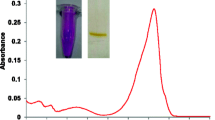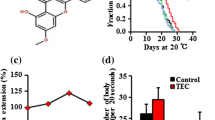Abstract
The allophycocyanin (APC) protein purified from Phormidium sp. A09DM was investigated for its in vivo antioxidant and anti-aging potential in Caenorhabditis elegans. An increased mean lifespan of APC-treated (100 μg/ml) worms (wild type) were observed from 16 ± 0.2 days (control) to 20 ± 0.1 days (treated). APC-treated worms also showed improved physiological marker of aging such as the rate of pharyngeal pumping and higher rate of survival against oxidative and thermal stress. Furthermore, APC was found to moderate the expression of human amyloid beta (Aβ1–42) as well as associated Aβ-induced paralysis in the transgenic C. elegans CL4176 upon increase in temperature. Furthermore, RNA interference (RNAi)-mediated studies revealed the dependence of downstream regulator daf-16, independent of stress-induced resistance gene skn-1 in the APC treated C. elegans. In the present study, we tried to demonstrate the anti-aging activity, longevity and protective effects of APC against cellular stress in C. elegans, which can lead to the use of this biomolecule in drug development for age-related disorders.






Similar content being viewed by others
Abbreviations
- C. elegans :
-
Caenorhabditis elegans
- PE:
-
Phycoerythrin
- PC:
-
Phycocyanin
- NGM:
-
Nematode growth medium agar plate
- CGC:
-
Caenorhabditis Genetic Center
- ROS:
-
Reactive oxygen species
- Aβ:
-
Amyloid-beta
- PBP:
-
Phycobiliprotein
- SDS:
-
Sodium dodecyl sulfate
- PAGE:
-
Polyacrylamide gel electrophoresis
- L4:
-
Larval stage 4
- H2O2 :
-
Hydrogen peroxide
- DCFH-DA:
-
Dichloro-dihydro-fluorescein-diacetate
- PQ:
-
Paraquat
References
Andriollo-Sanchez M, Hininger-Favier I, Meunier N et al (2005) Age-related oxidative stress and antioxidant parameters in middle-aged and older European subjects: the ZENITH study. Eur J Clin Nutr 59:S58
Bennett A, Bogorad L (1973) Complementary chromatic adaptation in a filamentous blue-green alga. J Cell Biol 58:419–435
Blagosklonny MV (2008) Aging: ROS or TOR. Cell Cycle 7:3344–3354. https://doi.org/10.4161/cc.7.21.6965
Cai W-J, Huang J-H, Zhang S-Q et al (2011) Icariin and its derivative icariside II extend healthspan via insulin/IGF-1 pathway in C. elegans. PLoS ONE 6:e28835. https://doi.org/10.1371/journal.pone.0028835
Chaubey MG, Patel SNK, Rastogi RP et al (2019) Therapeutic potential of cyanobacterial pigment protein phycoerythrin: in silico and in vitro study of BACE1 interaction and in vivo Aβ reduction. Int J Biol Macromol. https://doi.org/10.1016/j.ijbiomac.2019.05.006
Cohen E, Bieschke J, Perciavalle RM et al (2006) Opposing activities protect against age-onset proteotoxicity. Science 313:1604–1610
Drechsel DA, Patel M (2009) Paraquat-induced production of reactive oxygen species in brain mitochondria. Methods Enzymol 456:381–393
Grossman AR, Bhaya D, Apt KE, Kehoe DM (1995) Light-harvesting complexes in oxygenic photosynthesis: diversity, control, and evolution. Annu Rev Genet 29:231–288
Harrington LA, Harley CB (1988) Effect of vitamin E on lifespan and reproduction in Caenorhabditis elegans. Mech Ageing Dev 43:71–78. https://doi.org/10.1016/0047-6374(88)90098-X
Huang C, Xiong C, Kornfeld K (2004) Measurements of age-related changes of physiological processes that predict lifespan of Caenorhabditis elegans. Proc Natl Acad Sci USA 101:8084–8089. https://doi.org/10.1073/pnas.0400848101
Ishii N, Senoo-Matsuda N, Miyake K et al (2004) Coenzyme Q10 can prolong C. elegans lifespan by lowering oxidative stress. Mech Ageing Dev 125:41–46
Iwasa H, Yu S, Xue J, Driscoll M (2010) Novel EGF pathway regulators modulate C. elegans healthspan and lifespan via EGF receptor, PLC-γ, and IP3R activation. Aging Cell 9:490–505. https://doi.org/10.1111/j.1474-9726.2010.00575.x
Kamath RS, Ahringer J (2003) Genome-wide RNAi screening in Caenorhabditis elegans. Methods 30:313–321
Kampkötter A, Pielarski T, Rohrig R et al (2007) The Ginkgo biloba extract EGb761 reduces stress sensitivity, ROS accumulation and expression of catalase and glutathione S-transferase 4 in Caenorhabditis elegans. Pharmacol Res 55:139–147
Kazuko S, Kuniko F, Keiko Y, Takashi N (1992) Antioxidative properties of xanthan on the autoxidation of soybean oil in cyclodextrin emulsion. J Agric Food Chem 40:945–948. https://doi.org/10.1021/jf00018a005
Link CD, Taft A, Kapulkin V et al (2003) Gene expression analysis in a transgenic Caenorhabditis elegans Alzheimer’s disease model. Neurobiol Aging 24:397–413
Morton EA, Lamitina T (2013) Caenorhabditis elegans HSF-1 is an essential nuclear protein that forms stress granule-like structures following heat shock. Aging Cell 12:112–120
Pandey T, Sammi SR, Nooreen Z et al (2019) Anti-ageing and anti-Parkinsonian effects of natural flavonol, tambulin from Zanthoxyllum aramatum promotes longevity in Caenorhabditis elegans. Exp Gerontol 120:50–61. https://doi.org/10.1016/j.exger.2019.02.016
Parmar A, Singh NK, Madamwar D (2010) Allophycocyanin from a local isolate Geitlerinema sp. A28DM (Cyanobacteria): a simple and efficient purification process 1. J Phycol 46:285–289
Patel SN, Sonani RR, Jakharia K et al (2018) Antioxidant activity and associated structural attributes of Halomicronema phycoerythrin. Int J Biol Macromol 111:359–369. https://doi.org/10.1016/j.ijbiomac.2017.12.170
Rastogi RP, Singh SP, Häder D-P, Sinha RP (2010) Detection of reactive oxygen species (ROS) by the oxidant-sensing probe 2′, 7′-dichlorodihydrofluorescein diacetate in the cyanobacterium Anabaena variabilis PCC 7937. Biochem Biophys Res Commun 397:603–607
Robida-Stubbs S, Glover-Cutter K, Lamming DW et al (2012) TOR signaling and rapamycin influence longevity by regulating SKN-1/Nrf and DAF-16/FoxO. Cell Metab 15:713–724. https://doi.org/10.1016/j.cmet.2012.04.007
Singh NK, Sonani RR, Rastogi RP, Madamwar D (2015) The phycobilisomes: an early requisite for efficient photosynthesis in cyanobacteria. EXCLI J 14:268–289. https://doi.org/10.17179/excli2014-723
Singh NK, Sonani RR, Awasthi A et al (2016) Phycocyanin moderates aging and proteotoxicity in Caenorhabditis elegans. J Appl Phycol 28:2407–2417. https://doi.org/10.1007/s10811-015-0772-5
Smith JV, Luo Y (2003) Elevation of oxidative free radicals in Alzheimer’s disease models can be attenuated by Ginkgo biloba extract EGb 761. J Alzheimers Dis 5:287–300
Sonani RR, Rastogi RP, Madamwar D (2015a) Antioxidant potential of Phycobiliproteins: role in anti-aging research. Biochem Anal Biochem 4:2161–1009
Sonani RR, Singh NK, Awasthi A et al (2014a) Phycoerythrin extends life span and health span of Caenorhabditis elegans. Age Dordr Neth 36:9717. https://doi.org/10.1007/s11357-014-9717-1
Sonani RR, Singh NK, Kumar J et al (2014b) Concurrent purification and antioxidant activity of phycobiliproteins from Lyngbya sp. A09DM: an antioxidant and anti-aging potential of phycoerythrin in Caenorhabditis elegans. Process Biochem 49:1757–1766. https://doi.org/10.1016/j.procbio.2014.06.022
Sonani RR, Gupta GD, Madamwar D, Kumar V (2015b) Crystal structure of Allophycocyanin from marine Cyanobacterium Phormidium sp. A09DM. PLoS ONE 10:e0124580. https://doi.org/10.1371/journal.pone.0124580
Sonani RR, Rastogi RP, Patel R, Madamwar D (2016) Recent advances in production, purification and applications of phycobiliproteins. World J Biol Chem 7:100–109. https://doi.org/10.4331/wjbc.v7.i1.100
Su H-N, Xie B-B, Chen X-L et al (2010) Efficient separation and purification of allophycocyanin from Spirulina (Arthrospira) platensis. J Appl Phycol 22:65–70
Takanashi T, Ogura Y, Taguchi H et al (1997) Fluorophotometric quantitation of oxidative stress in the retina in vivo. Invest Ophthalmol Vis Sci 38:2721–2728
Timmons L, Fire A (1998) Specific interference by ingested dsRNA. Nature 395:854
Uno M, Nishida E (2016) Lifespan-regulating genes in C. elegans. NPJ Aging Mech Dis 2:16010
Wan Q-L, Fu X, Dai W et al (2019) Hypotaurine promotes longevity and stress tolerance via the stress response factor DAF-16/FOXO and SKN-1/NRF2 in Caenorhabditis elegans. R Soc Chem 10:347–357
Wan Q-L, Fu X, Dai W et al (2020) Uric acid induces stress resistance and extends the life span through activating the stress response factor DAF-16/FOXO and SKN-1/NRF2. Aging 12:2840–2856. https://doi.org/10.18632/aging.102781
Yu P, Wu Y, Wang G et al (2017) Purification and bioactivities of phycocyanin. Crit Rev Food Sci Nutr 57:3840–3849
Acknowledgements
NKS acknowledges Science and Engineering Research Board (SERB), Department of Science and Technology (DST), Ministry of Science and Technology, Government of India, for Young Scientist fellowship under the scheme of startup research grant (SB/YS/LS-290/2013). MGC also acknowledges SERB for Senior Research Fellowship under the scheme of startup research grant (SB/YS/LS-290/2013).
Funding
The research was supported by the Department of Science and Technology (DST), Ministry of Science and Technology, Government of India under the scheme of startup research grant (SB/YS/LS-290/2013)
Author information
Authors and Affiliations
Contributions
Conceptualization: MGC, SNP; DM, RPR, NKS. Methodology: MGC, SNP; DM, NKS, RPR. Formal analysis and investigation: MGC, SNP; DM, NKS, RPR. Writing—original draft preparation: MGC. Writing—review and editing: DM, NKS, RPR. Resources: Shri. A. N. Patel P. G. Institute of Science and Research, Anand, Post Graduate Department of Bioscience, Sardar Patel University, Anand. Supervision: NKS, RPR.
Corresponding authors
Ethics declarations
Conflict of interest
Mukesh Ghanshyam Chaubey, Stuti Nareshkumar Patel, Rajesh Prasad Rastogi, Datta Madamwar and Niraj kumar Singh declare that they have no conflict of interest.
Ethics approval
No human or animal rights are applicable to this study.
Electronic supplementary material
Below is the link to the electronic supplementary material.
Rights and permissions
About this article
Cite this article
Chaubey, M.G., Patel, S.N., Rastogi, R.P. et al. Cyanobacterial pigment protein allophycocyanin exhibits longevity and reduces Aβ-mediated paralysis in C. elegans: complicity of FOXO and NRF2 ortholog DAF-16 and SKN-1. 3 Biotech 10, 332 (2020). https://doi.org/10.1007/s13205-020-02314-1
Received:
Accepted:
Published:
DOI: https://doi.org/10.1007/s13205-020-02314-1




